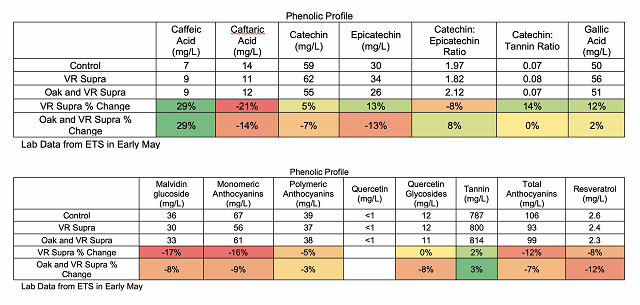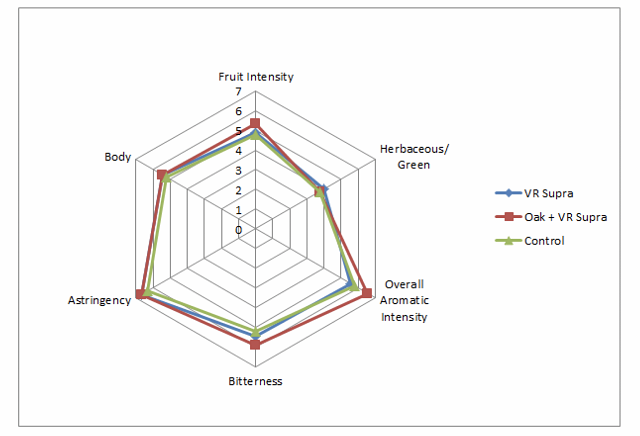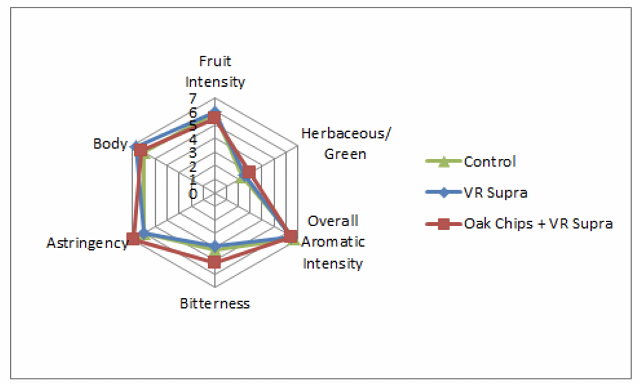The Effect of Tannin and Oak Addition on Merlot (2016)
Justin Rose
Rosemont Vineyards and Winery
Summary
This study examines the impact of adding either VR Supra (Laffort) or both VR Supra and untoasted oak chips on the sensory and chemical qualities of Merlot. Merlot was harvested on the same day from the same block and processed identically into three separate T Bins, one of which was a control, one of which received 30g/hL VR Supra, and one of which received both 30g/hL VR Supra and 2.5g/L untoasted French oak chips. All other treatments were the same between groups. The treatments underwent a 4 day cold soak, and two punchdowns per day until they reached 3 Brix. The wines were pressed 2 weeks after processing. No major differences could be seen in wine chemistry. Color was not impacted much, but the treatments lowered anthocyanins. Adding tannin and adding oak chips increased tannin. The differences between treatments, however, were not that great. Overall, conflicting results were found for the two tastings this project was poured at. At the Shenandoah tasting (May 3), most judges preferred the wine with both Oak Chips and VR Supra, whereas on May 17 that was the least preferred. Oak chips with VR Supra tended to increase Astringency and Bitterness, but this was a weak tendency. These results suggest that these wines could be tailored to meet the demands of different consumer groups. However, the number of judges in these studies were small, and in the future more work should be done on these wines. Additionally, this wine was unusually high in alcohol and extraction due to the vintage, and more of a difference with these treatments may be more observable in different vintages.
Introduction
Often oak chips, enological tannin, or even skins from other grapes are added to must prior to the onset of fermentation. It is thought that these additions may help prevent oxidation, enhance color stability, and enhance phenolic quality and mouthfeel. They may also ameliorate tannin problems from unripe or damaged fruit, increase the amount of tannin available to form polymeric pigment, and reduce vegetal aroma (Zoecklein 2005). Some authors have observed that exogenous tannin can both enhance the final concentration of anythocyanin in wine after 72 hours of fermentation (Giacosa et al. 2017). It is not clear from this study how stable this difference in wine is over time. These effects all depend on the source and kind of tannin (hydrolysable vs condensed tannin). All grape-derived tannin is condensed tannin, whereas hydrolysable tannin comes from oak wood or additives (Zoecklein 2005).
The timing of tannin addition will greatly impact the effect of these tannins, with earlier additions having less of an impact. Although pre-fermentation additions may help the exogenous tannin to integrate more fully with grape phenolics to form polymeric pigment, yeast cell walls will often bind tannin during precipitation, thus in effect “fining” tannin out of wine (Zoecklein 2000; Zoecklein 2005). Additionally, sometimes tannin addition can result in protein precipitation in must, causing a cascade of tannin precipitation which could actually result in lower tannin concentration in the finished wine (Steve Price, 2017, personal communication). This study examines the impact of tannin addition and oak chip addition on the sensory and phenolic characteristics of wine.
Results and Discussion
No major differences could be seen in wine chemistry. The differences in ethanol is likely due to minor differences which occurred during watering back each T Bin. Color was not impacted much, but the treatments lowered anthocyanins. Adding tannin and adding oak chips increased tannin. The extra increase from oak chips may have been due to hydrolysable tannin acting as a sacrificial antioxidant, protecting tannin. The differences between treatments, however, were not that great.


On the May 3 tasting, in general judges tended to prefer the wine made with Oak + VR Supra the most, and the Control the least. However, there were not many votes. There were no strong trends for the descriptors used in this study. There was a slight tendency for the Oak + VR Supra treatment to increase Fruit Intensity, Overall Aromatic Intensity, and Bitterness. The Control wine tended to have slightly lower Astringency. Comments by some judges suggest that the samples may have had some slight oxidation issues (acetate).


For the May 17 tasting, no strong trends were found with the descriptors used in this study. Oak Chips with VR Supra tended to slightly increase Bitterness and Astringency more than the other treatments. In general, judges showed a slight preference for the Control wine.


Overall, conflicting results were found for the two tastings at which this project was poured. At the Shenandoah tasting (May 3), most judges preferred the wine with both Oak Chips and VR Supra, whereas on May 17 that was the least preferred. Oak chips with VR Supra tended to increase Astringency and Bitterness, but this was a weak tendency. These results suggest that these wines could be tailored to meet the demands of different consumer groups. However, the number of judges in these studies were small, and in the future more work should be done on these wines. Additionally, this wine was unusually high in alcohol and extraction due to the vintage, and more of a difference with these treatments may be more observable in different vintages.
Methods
Merlot (12 year old vines, Clone 343 planted on RG) was harvested on 9/11/2016 and destemmed into T Bins on 9/12. The T Bins were set up so that one did not receive any treatments, one T Bin received 30g/hL VR Supra tannin, and one T Bin received 30 g/hL VR Supra and 2.5g/L Untoasted French oak chips. Each bin received 50ppm sulfur dioxide. The treatments underwent a 4 day cold soak at 50°F, and afterwards all were inoculated with FX10 at 25g/hL with 30g/hL Dynastart. During fermentation, 30g/L Thiozote and 30g/hL Nutristart Org were added. The fermentations were punched down twice daily until 3 Brix, after which they were punched down once per day. After pressing (9/26), Laconenos 450 PREAC malolactic bacteria was added to the wines.
This project was tasted on May 3 and May 17. In order to balance the data set to perform statistical analysis for descriptive analysis on the May 3 tasting, any judge who had not fully completed the descriptive analysis ratings were removed. In order to then make the number of judges between groups equivalent, one judge from group 1 and group 3 were eliminated. This resulted in a final data set of 3 groups, each with 3 judges (considered as replications within groups, and groups were considered as assessors). Data was analyzed using Panel Check V1.4.2. Because this is not a truly statistical set-up, any results which are found to be statistically significant (p<0.05) will be denoted as a “strong trend” or a “strong tendency,” as opposed to general trends or tendencies. The statistical significance here will ignore any other significant effects or interactions which may confound the results (such as a statistically significant interaction of Judge x Wine confounding a significant result from Wine alone). The descriptors used in this study were Fruit Intensity, Herbaceous/Green, Overall Aromatic Intensity, Bitterness, Astringency, and Body.
The same procedures for data analysis were used on the May 17 tasting. For the descriptive analysis in this tasting, each group had two judges, for a total of 6 judges (one judge was removed from group 1 and one was removed from group 3 to balance the data set).
References
Giacosa, S., Segade, S.R., Rolle, L., and Gerbi, V. 2017. Study of the role of exogenous tannins in color preservation during the early stages of maceration. Universitá degli studi di torino.
Steve Price, Personal Communication, 2017.
Zoecklein, B. 2000. Wine structural development. Enology Noes #8. http://www.apps.fst.vt.edu/extension/enology/EN/8.html.
Zoecklein, B. 2005. Enological tannins. Enology Notes #103. http://www.apps.fst.vt.edu/extension/enology/EN/103.html.
